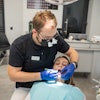
Over-the-counter analgesics can effectively treat orthodontic pain, according to a review published on August 11 in the Journal of Evidence-Based Dental Practice. The analysis found no significant differences in pain relief between common nonsteroidal anti-inflammatory drugs (NSAIDs) and acetaminophen.
The review included 12 publications and a total of 587 patients. To find the studies, researchers searched online databases using the terms "orthodontic treatment, "pain or discomfort," and "analgesic drugs."
The reviewed studies compared a placebo as a control and at least one of three analgesic drugs: ibuprofen, naproxen, and acetaminophen. To gauge the efficacy of the analgesics, researchers measured pain according to a 10-point visual analog scale (VAS) at time intervals ranging from two to 24 hours following placement of orthodontic fixed appliances.
"Research on analgesic effectiveness shows that the post-operative pain intensity determines our ability to measure analgesic effectiveness," wrote the study authors, led by Dr. Kenneth Markowitz of Rutgers School of Dental Medicine in Newark, NJ.
In collecting data, researchers attempted to answer the following questions:
- Is orthodontic pain sufficient enough to require the use of analgesics?
- Do the results of randomized controlled clinical studies prove that analgesics alleviate orthodontic pain?
- Does the evidence indicate that some analgesics are more effective than others?
The analysis showed significantly less pain in patients treated with acetaminophen, ibuprofen, or naproxen compared to patients who received a placebo. The analgesic-treated patients experienced pain scores of at least one VAS unit lower than the scores in placebo-treated patients.
The study findings indicate that all three analgesics reduced pain at time points where pain intensity was the highest. Pain scores of orthodontic clinical trials tended to be highest, particularly at the 12-hour time point (with patients rating the pain between four and five on the 10-point VAS scale).
While one analgesic did not have a significant benefit over others in the analysis, the findings led the authors to conclude that one type of medication still has an advantage over the others for orthodontic patients.
"In balancing the risks versus benefits of various analgesics in orthodontic pain treatment the observation that acetaminophen works well and the concern that NSAIDs may hinder orthodontic tooth movement should lead clinicians to select acetaminophen as the first-choice analgesic for the management of orthodontic treatment-related pain," Markowitz and colleagues concluded.



















